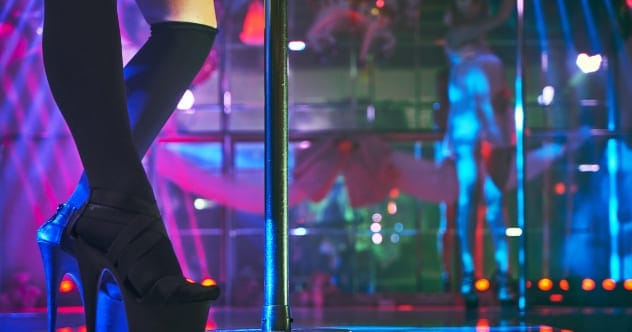When you think of strippers, a whirlwind of stereotypes likely dances through your mind. But what’s the real story behind the glitter and the poles? While some common ideas hold a sliver of truth, many are far from reality. For instance, not every dancer is a woman reluctantly taking the stage or just ‘working through college’ – though, surprisingly, about one-third of strippers are indeed pursuing higher education to fund their studies. Today, we’re peeling back the layers on this profession, which dates back an astonishing 9,000 years, to reveal 10 genuinely weird facts about strippers that might just change your perspective.
10 The Demand for Male Strippers is Surprisingly Low
You might think movies like “Magic Mike” would skyrocket the demand for male strippers. While more men are indeed stepping onto the stage, the numbers are still quite low. In the U.S., a whopping 92% of strippers are women, leaving only 8% as men. That means for every male stripper, there are about nine female dancers. This imbalance helps explain why most people picture a woman when they hear the word ‘stripper’.
However, these figures mainly cover club performers and don’t always account for private party entertainers. Think about those surprise guests at bachelorette parties! It’s possible that women prefer to book male strippers for private events rather than going to a club. And no, unfortunately, Channing Tatum probably isn’t available for your next party – that was just a movie role!
9 Stripping Can Be a Long-Term Career
Many people think stripping is just a short-term gig for the young, or perhaps a job with no future. But some dancers prove this wrong by building lasting careers. They treat stripping like a business, create a loyal following, and even offer pole dancing classes. These classes can provide ongoing income, as many enjoy pole dancing for fitness, not just performance.
The earnings and skills gained from stripping have launched other entertainment careers too. Famous rapper Cardi B, for example, danced to pay her bills and fund her music dreams. You can still spot her incredible dance skills in her videos. Courtney Love, known for her band Hole, also used her stripping income to kickstart her music career.
And age isn’t always a barrier. While the average stripper might be in their early twenties, about 6% have been dancing for two decades or more! Staying fit and positive is key. Makeda Smith, for instance, started stripping in her 50s and gained fame after a video of her went viral. It’s more common than you think to find dancers well into their 40s, 50s, and 60s. There’s even a club in Atlanta, the Clermont Lounge, known for featuring older strippers aged 45-60.
8 Role-Playing and Dancing Can Come Hand in Hand
While athletic dancing is their primary skill, some high-end clubs also encourage strippers to embrace themed costumes and role-play. Several unique and popular stripping venues in the U.S. feature distinctive role-playing experiences. For instance, Pirate’s Cove in Portland, Oregon, is designed like a giant rum jug, with dancers catering to pirate enthusiasts.
If Halloween is your favorite holiday, the Silver Dollar Strip Club in Eugene, Oregon, offers spooky rooms where costumed strippers might just give you a delightful fright. And let’s not overlook the School House in Neoga, Illinois. This school-themed club displays multiplication tables and even a copy of the local Pioneer school’s constitution near the stripper poles. For sci-fi fans, an L.A. spot modeled after the Mos Eisley Cantina hosts Star Wars nights, where strippers dress as iconic characters – yes, even stormtroopers. These are definitely the performers you’re looking for!
7 Female Strippers Can Work Through Anything… Even That Time of Month
Yes, you read that right. For female strippers, their monthly cycle doesn’t necessarily mean time off. If they feel up to it, many continue to work. With most of their job focused on dancing, a discreetly managed tampon (string snipped) and perhaps some pain relief for cramps can do the trick. They can then get back to work, ready to perform.
Interestingly, some women report a higher libido during their period. This surge in confidence and energy can sometimes translate to even better tips. So, while it might seem like a challenge, many strippers manage it professionally and can even find it a surprisingly lucrative time.
6 You Need The Right Attitude To Be Successful
Contrary to some portrayals, most strippers choose the profession because they genuinely enjoy dancing and feel confident in their bodies. It requires real talent and dedication to master the skills needed for captivating pole work. Many dancers find a boost in self-esteem and enjoy the playful aspect of performing. This genuine enjoyment and confidence often attract more clients and lead to better earnings.
Being a stripper also demands a resilient mindset. While societal acceptance is growing, some people still cling to negative stereotypes and judge those who choose this path. Dancers can’t let this negativity affect them. On the job, they also face rejection, as not every client will be drawn to their specific look or dance style. Successful strippers learn not to take these things personally, maintaining a professional and positive outlook.
5 Strippers Are Healthy And Work in Clean Environments
This fact might seem weird only because of the persistent myth that strip clubs are grimy places fostering drug use and STDs. The reality is often quite different. Most strippers prioritize their health, often have health insurance, and work hard to maintain the physique needed for demanding pole routines. Regular gym workouts and clean eating are common practices. A survey even indicated that around 90% of strippers have religious backgrounds and maintain close relationships with their parents, debunking the idea that they’re all rebellious or estranged.
As for the clubs themselves, many are responsibly run businesses. They adhere to health codes, possess valid liquor licenses, and strictly prohibit drug use on their premises. You might even find surprisingly good food at some clubs, like The Venetian Gentlemen’s Club in Orange County, California, which hosts the Sushi Dave restaurant. Imagine enjoying quality sushi while watching the main stage performances from the second floor!
4 Strippers Have a Wide Range in Earning Potential
You’ve probably heard tales of strippers making more in one night than many people earn in a week. While this can happen, it’s not a consistent reality for everyone. A stripper’s earnings can vary wildly based on factors like their shift timing, the day of the week, and how many customers visit during that particular shift. Pay also differs depending on the club’s reputation, the city it’s in, and the clientele.
In the United States, the average annual salary for strippers can range anywhere from $19,000 to $140,000. Cardi B mentioned in an interview that she started dancing at 19 and had saved around $20,000 by age 20. However, newcomers or those dancing during slower periods might only make a few dollars on some nights.
Earnings can also be seasonal, especially for those who specialize in private parties. Summer usually sees more events than the holiday season. From November to March, private party strippers might experience a significant dip in work. Some travel to places like Las Vegas on weekends to tap into high-end club earnings. Budgeting and saving are crucial skills in this line of work.
3 Stripping Existed Thousands of Years Ago
Stripping isn’t some modern sign of declining morals or societal collapse. In fact, forms of it were part of ancient rituals, religious practices, and yes, brothels too. Archaeologists in Bulgaria and Romania have unearthed stripper statuettes dating back over 9,000 years! Many ancient religions featured sex deities who, for various reasons, disrobed.
For example, in Ancient Greece, dancers would strip as part of fertility rites at temples, slowly removing animal furs they wore. These dancers often became priestesses and viewed their services as an honor. Separately, Ancient Greek brothels, dating back to at least the 6th century BC, also featured women dancing naked to entertain patrons. The Sumerians had strippers performing in rituals for the goddess Inanna’s journey to the Underworld, where performers removed clothing piece by piece to mimic the goddess’s trials. Ancient Rome also had strippers, often considered actresses, who used erotic dance in theatrical plays to captivate audiences. While some historical accounts link stripping to the world of slavery, these examples show that dancing wasn’t always seen negatively; ancient communities often viewed strippers as religious figures or professional entertainers.
2 Strippers Get Asked to Do Crazy Things Besides Dance

It’s probably not shocking that unusual things can happen in a strip club, but some client requests are truly out there. Sometimes, strippers are asked to do much more than just remove their clothes – and it’s often not what you’d expect. One dancer shared that a man paid a significant amount of money just to smell her G-string after a dance. She simply had to allow him a quick, respectful sniff. Definitely an odd one!
And some of these quirky favors aren’t even overtly sexual. Another stripper mentioned a regular customer who wasn’t interested in lap dances but instead wanted to search for lint between her toes. He would keep paying for songs until his ‘search’ was complete. She once earned a $100 tip after pre-emptively placing a bit of lint there for him to ‘discover’. Talk about a unique treasure hunt!
1 Most Strippers Have Unexpected Daytime Jobs

For many, stripping is a way to express their passion for dance or a means to an end while pursuing other goals. With growing acceptance, it’s a lifestyle choice for some. Roughly 60% of female strippers dance part-time and hold down some surprisingly conventional day jobs. Given teacher salaries in some areas, it might not be too astonishing to learn that about 14% of strippers also work as teachers during the day. Other common professions include analysts and even mathematicians.
As mentioned earlier, Makeda Smith balanced her dancing career in her 50s with a high-profile career in the entertainment industry. She runs her own PR agency and has worked as a publicist for celebrities like Mo’Nique and Jamie Foxx. This just goes to show the diverse backgrounds and ambitions of people in the stripping profession.
So, there you have it – 10 weird facts that peel back the curtain on the world of stripping. From its ancient roots and surprising demographics to the entrepreneurial spirit of its performers and their unexpected day jobs, it’s clear there’s much more to this profession than meets the eye. These truths challenge common stereotypes and paint a far more complex and fascinating picture.










